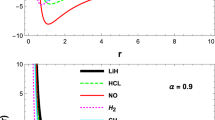Abstract
The energy functional of a novel electronic structure theory, OP-NSOFT, has as variables the natural spin orbitals (NSO) of the trial function and their joint occupation probabilities in the search for the ground state energy. When occupancy is restricted to the spin-paired NSOs of DOCI, the resulting theory, OP-NSOFT-0, scales as M3, with M the size of the one-electron basis set. Accurate results were obtained for small molecules, particularly near dissociation where single reference theories like DFT are inaccurate. The homogeneous electron liquid (HEL) could serve as a test bed of OP-NSOFT for condensed systems, but OP-NSOFT-0 reduces to the Hartree–Fock approximation for the HEL. Cooper pairing is introduced instead, both singlet pairing, OP-NOFT-Cs, and fully polarized triplet pairing, OP-NSOFT-Ct. The former yields 1/3 of the diffusion-Monte-Carlo correlation energy, the latter 1/2 to 1/3 with decreasing electron density for rs values between 1 and 10. Both yield the discontinuity in the single-particle occupation number required by the Luttinger theorem. Two-state joint occupation probabilities illustrate the importance of electron–electron small-angle scattering in establishing electron correlation in the unpolarized HEL.
Similar content being viewed by others
References
P. Hohenberg, W. Kohn, Phys. Rev. 136, B864 (1964)
W. Kohn, L.J. Sham, Phys. Rev. 140, A1133 (1965)
T.L. Gilbert, Phys. Rev. B 12, 2111 (1975)
M. Piris, Phys. Rev. Lett. 119, 063002 (2017)
R. van Meer, O.V. Gritsenko, E.J. Baerends, J. Chem. Phys. 148, 104102 (2018)
K. Pernal, K.J.H. Giesbertz, Top. Curr. Chem. 368, 125 (2016)
J.M. Herbert, J.E. Harriman, Chem. Phys. Lett. 382, 142 (2003)
M. Piris, Int. J. Quantum Chem. 113, 620 (2013)
M. Piris, J.M. Ugalde, Int. J. Quantum Chem. 114, 1169 (2014)
A.J. Coleman, Rev. Mod. Phys. 35, 668 (1963)
C. Garrod, J.K. Percus, J. Math. Phys. 5, 1756 (1964)
J. Percus, Comput. Theor. Chem. 1003, 2 (2013)
Z. Zhao, B.J. Braams, M. Fukuda, M.L. Overton, J.K. Percus, J. Chem. Phys. 120, 2095 2004
M. Nakata, H. Nakatusuji, M. Ehara, J. Chem. Phys. 114, 8282 (2001)
G. Gidofalvi, D.A. Mazziotti, J. Chem. Phys. 129, 134108 (2008)
R. Gebauer, M.H. Cohen, R. Car, Proc. Nat. Acad. Sci. 113, 46 (2016); referred to as I. There, the acronym used was OP-NOFT for occupation-probability-based natural-orbital functional theory, which here has been replaced by OP-NSOFT occupation-probability-based natural-spin-orbital functional theory as more accurate
P.O. Löwdin, Phys. Rev. 97, 1474 (1955)
D.A. Mazziotti, Phys. Rev. Lett. 101, 253002 (2008)
M. Piris, J.M. Matxain, X. Lopez, J. Chem. Phys. 139, 234109 (2013)
D.M. Ceperly, B.J. Alder, Phys. Rev. Lett. 45, 566 (1980)
G. Ortiz, P. Ballone, Phys. Rev. B 50, 1391 (1994)
G. Ortiz, P. Ballone, Erratum Phys. Rev. B 56, 9970 (1997)
N.N. Lathiotakis, N. Helbig, E.K.U. Gross, Phys. Rev. B 75 195120 (2007)
J. Bardeen, L.N. Cooper, J.R. Schrieffer, Phys. Rev. 106, 162 (1957)
A.J. Leggett, Phys. Rev. Lett. 29, 1227 (1972)
K. Pernal, J. Cioslowski, J. Chem. Phys. 120, 5987 (2004)
P.W. Ayers, S. Liu, Phys. Rev. A 75, 022514 (2007)
P.W. Ayers, E.R. Davidson, Adv. Chem. Phys. 134, 443 (2007)
B. Lukman, J. Koller, B. Borstnik, A. Azman, Mol. Phys. 18, 857 (1970)
W.B. England, J. Phys. Chem. 86, 1204 (1982)
W.B. England, Int. J. Quantum Chem. 23, 905 (1983)
M. Piris, R. Cruz, Int. J. Quantum Chem. 53, 353 (1995)
M. Piris, L.A. Montero, N. Cruz, J. Chem. Phys. 107, 180 (1997)
V.N. Staroverov, G.E. Scuseria, J. Chem. Phys. 117, 2489 (2002)
V.N. Staroverov, G.E. Scuseria, J. Chem. Phys. 117, 11107 (2002)
G. Csanyi, T.A. Arias, Phys. Rev. B 61 7348 (2000)
M. Piris, P. Otto, J. Chem. Phys. 112, 8187 (2000)
J.M. Blatt, Prog. Theor. Phys. 23, 447 (1960)
A.J. Coleman, J. Math. Phys. 6, 1425 (1965)
S. Bratoz, P.h. Durand, J. Chem. Phys. 43, 2670 (1965)
J.M. Luttinger, Phys. Rev. 119, 1153 (1960)
F. Bloch, Z. Phys. 57, 545 (1929)
F.H. Zong, C. Lin, D.M. Ceperley, Phys. Rev. E 66, 036703 (2002)
D. Ceperley, Phys. Rev. B 18, 3126 (1978)
Author information
Authors and Affiliations
Corresponding author
Additional information
Contribution to the Topical Issue “Special issue in honor of Hardy Gross”, edited by C.A. Ullrich, F.M.S. Nogueira, A. Rubio, and M.A.L. Marques.
Rights and permissions
About this article
Cite this article
Gebauer, R., Cohen, M.H. & Car, R. Occupation probabilities as variables in electronic structure theory: cooper pairing, OP-NSOFT-Cs,t, and the homogeneous electron liquid. Eur. Phys. J. B 91, 244 (2018). https://doi.org/10.1140/epjb/e2018-90242-2
Received:
Published:
DOI: https://doi.org/10.1140/epjb/e2018-90242-2




